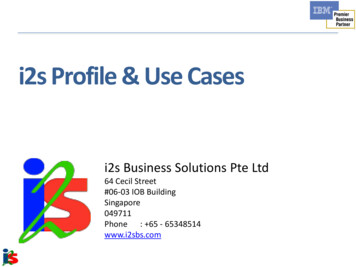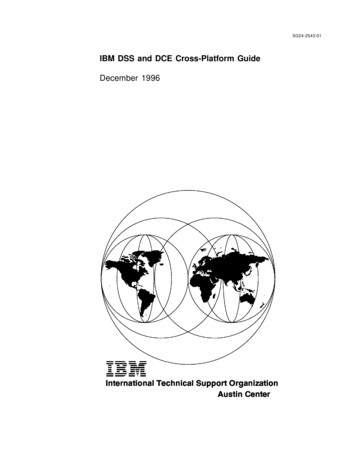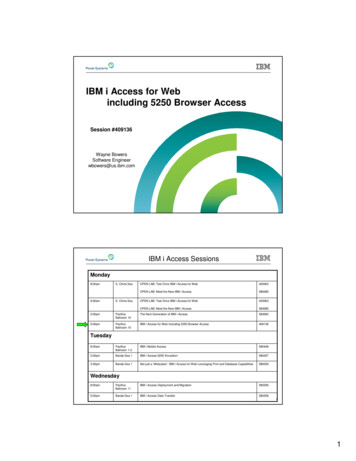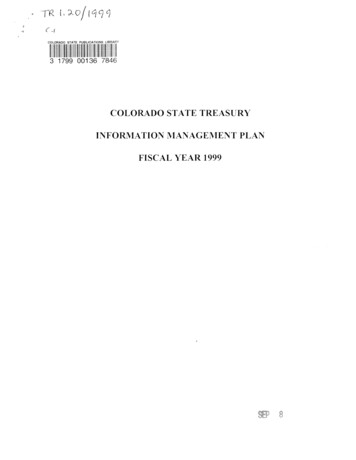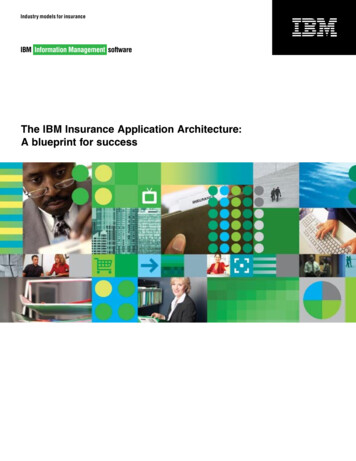
Transcription
Industry models for insuranceThe IBM Insurance Application Architecture:A blueprint for success
Industry models for insuranceExecutive summaryAn ongoing transfer of financial responsibility to end customers has created a whole new level of informed,active consumers who seek increased services and convenience from the insurance industry. At the sametime, technology has enabled an increasing number of niche service providers to enter the market. As a result,insurers have begun to reexamine ways to increase the speed at which they can respond to an increasinglyinformed and demanding customer base, new regulations, and emerging marketplace changes.Often, however, a complex web of legacy silos, disparate systems, redundant functionality and excess capacityprevent insurers from achieving the agility and flexibility needed to operate on demand. This complexity resultsin redundant processes, excess costs and an inability to leverage and retrieve critical information when andwhere it’s needed.These complex business models must be simplified — not unit by unit, process by process or product by product,but across the entire organization. Insurers need to establish a common framework and language of thebusiness concepts, standards and data definitions to ensure their IT investments contribute to a consistentand, flexible architecture. This strategy helps reduce the expense of integration and increase the velocityand accessibility of information. But while that may be the end goal, there are many steps involved. For manyorganizations the question is, where and how to get started?That’s where the IBM Insurance Application Architecture(IAA) comes in. It’s a comprehensive suite of modelscomprising of data, process and service-based modelsthat help insurers accelerate the planning andrequirements analysis of business process transformation, core system renewal and consolidatedreporting solutions. It contains the proven businessknowledge and best practices required to support criticalbusiness issues and ensure that IT projects are linkedwith business requirements. In addition, it provides acommon blueprint of an overall framework for handlingrisk management and regulatory compliance, as well asIBM Industry Models speak the language of business.re-engineeing, broadening and standardizing corebusiness processes or implementing new business process architectures. Together, these capabilities canhelp you gain a more complete understanding of customer buying behavior, loyalty and the effectivenessof your marketing activities.This executive brief explains how IBM can help your company leverage the Insurance Application Architecture.In addition, it outlines the specific resources IBM has developed, including the IAA process andservice models, including: The IAA process and service models, a content-rich set of models designed specifically for insurance firmsto enable the creation or optimization of enterprise-wide processes, and the supporting SOA services andcomponent-based development. The IAA data models that provide a blueprint for a comprehensive data warehouse and analysis templatesfor use by business intelligence applications.
Industry models for insuranceVision for the futureWhat will the insurance industry look like in 2020 ? To gain a clearerunderstanding of the future of the industry, the IBM Institute for Business Valueconducted interviews and market research among global industry executives.The collected information pointed to the following key findings:quickly to new regulations and ensure processes are consistentacross products and channels. Inaccurate information can Old modes of thinking threaten the industry’s ability to innovate.expose the company to significant regulatory and government Interlopers will increasingly disrupt traditional insurance operations.compliance risk. I ndustry leadership will require experimentation in operating models,processes, products and customer relationships. Strategic investment in innovation today is critical to success in 2020.The Component Business Model from IBM can help by simplifying the way insurance organizations look at their operations.Viewing business activities as autonomously managedIn response, IBM has developed quantititve models that combine historicalcomponents that can be optimized individually for greaterperspectives with potential disruptive forces to create a vision of the future —value to the whole business enables decision makers to cutwith actionable recommendations.through historical boundaries that may have built up alongorganizational, product, channel, customer, geographical andinformational lines.Simplifying processes to maximize profitabilityIt enables insurers to see efficiencies and places whereOver the years, many insurers have accumulated a complexcomponents can be reused across the organization.infrastructure made up of isolated systems rigidly tied to theirFor example, the vast majority of the different regulatoryown processes, systems and specific channels. It’s estimatedinitiatives require data to be collected, analyzed and reportedthat nearly 70 percent of budget goes to maintaining thesein different formats and under different timescales. But thelegacy systems. The result is that there is very little flexibilitydata needed to comply with one regulation may also beto adapt to changing consumer, regulation and marketplacerequired for other regulations. By collecting data once andchanges. For example, something as simple as buildingmaking it available across integrated structures, insurers cannew management reports for a new area of the businesssave significant time and costs as well as helping to ensurecan require significant time and costs. At the extreme end,consistency. Or a business process such as loan originationa major product rollout can take years to fully implementcan be built once and then reused across different areas,across all lines of business and geographies.such as savings, mortgage or equity.Insurers can no longer afford to have information and analysisA natural extension to the Component Business Model, the IAAcapabilities duplicated across inflexible channel or systemfrom IBM is easily customized to cover specific requirements.silos that drain IT resources and inhibit responsiveness.The IAA business models help insurers identify, describe andBusiness users need consistent, relevant information to combatstructure all of the business functions, data and processes inthe new trends through better decision making, innovativeproducts and superior service. For compliance measures,insurers must maintain data for reporting requirements, adapt
Industry models for insuranceImplementing IAA process and service models from IBM can help you: I dentify opportunities to streamline and outsource processes and be more responsive to customers. Reduce time-to-market with new products, such as online portfolio management. Strengthen the retail network by integrating multiple channels. Integrate a merger and legacy systems more quickly. R eengineer processes to comply with regulatory requirements. F acilitate a reliable mechanism for information availability across the organization such ascustomer data integration.an objective manner that can be understood by both IT andInsurance organizations can leverage the entire framework,business users. In addition, they can help establish a stream-including:lined, efficient organization where services are built once andreused many times across multiple lines of business, enablingProcess and service modelsorganizations to:While many insurers want to reengineer and standardize theircore enterprise-wide business processes, it can be difficult Identify and prioritize initiatives for delivering business value.to know where to start. Many business processes that have Create a single source of customer information andessentially the same purpose are ultimately carried out in verydifferent ways in various organizational units of insurers. Thereporting efforts.different process flows are typically the result of multiple siloed Achieve a single architecture to address all compliancesystems that have come from years of mergers and acquisi-issues over time.tions, with varying levels of automation, multiple organization Employ a comprehensive and consistent dictionarystructures, and the continued introduction of new productsfor describing business issues, applications and components.and channels. Eventually, these overlapping processes cansignificantly increase costs and complexity, while decreasingflexibility and customer service. These problems are exacerbated by mergers and acquisitions, new products or channels,and multiple lines of business.
Industry models for insuranceThe truth is that while they are called different things,They describe the most important step-by-step processesmany of these business processes have essentially thewithin an organization, ranging from front to back officesame process from front to back office functions, such asfunctions, such as sales and marketing management,channel management, customer acquisition and underwriting.payments, lending, and HR administration. Pre-analyzed andUsing a framework enables you to streamline processestested templates are populated with 80 percent of the contentacross the organization, eliminating existing redundancies,required to describe banking operations, giving processwhile enabling you to:re-engineering projects a quick start. These templates canbe used to re-engineer existing approaches or to deploy Deliver a consistent customer experience across channels.new capabilities. In addition, they provide a consistent, Decrease IT costs needed to support disparate processes.enterprise-wide lexicon for identifying and naming organiza- Introduce best practices in an enterprise-wide fashion.tional activities and the triggers within key business processes, Facilitate compliance efforts with policies and regulations.and a fast path to an enterprise-wide business processarchitecture and documenting business requirements.Unfortunately, capturing and coming to an agreement onThe end result is the potential for huge savings in developmentdefinitions can be a major stumbling block for manytime and resources during the analysis and design stages oforganizations. The IBM process models play a critical rolea business process reengineering project.by helping insurers analyze and compare their own businessprocesses to best practice business processes, such asThe IBM service models enable business and IT to agreemarketing and customer relationship management, in aupon the scope of services to be developed and deployeddisciplined, objective manner. The models cover major areaswithin a service-oriented architecture (SOA). Specifically,of insurance processes such as:they enable analysts and developers to capture businessrequirements through the use of cases, thereby identifying Enterprise Resource Managementappropriate service definitions that form the entry point into Channel management and CRMan underlying integration infrastructure. For example, Communications managementorganizations can leverage them to: Marketing and customer acquisition Product portfolio management Claim management and policy administration Create common business components for core systemrenewal projects. Underwriting and financial transactions Provide service definitions that implement the process models. Reinsurance management Enable the deployment of enterprise-wide information Investment managementas a service. Provider management
Industry models for insuranceIBM Insurance Data WarehouseThe IIW:Just as processes have become a tangled web of complexityfor many insurers, the information needed to understand D elivers competitive advantage by enabling the consolidation of cleancustomers and operations is often spread across numerousdata across multiple channels, and products.information silos and in multiple formats. The problem is not ashortage of data or reporting systems — it’s the fact that it’s notavailable in a consolidated and business analysis format that S upports rapid implementation of warehousing solutions with meaningfulinsurance data.clearly indicates trends, patterns or other forms of analysis. F acilitates a structured approach to subsequent customization andextension of the data warehouse.Getting relevant information into the hands of business userscan help you combat industry challenges through better E nables business users to more effectively control and reduce the timedecision making, consistent reporting, differentiated productstaken to scope their requirements.and superior service. This means delivering information tothe users in a form that directly mirrors the Key Performance P rovides a solid basis for statutory reporting and relationship managementIndicators of the business. The data feeding these KPI metricsneeds to have been pre-integrated and of sufficient data quality.Defining the KPIs and the IT infrastructure necessary to bringsupporting decision support and executive information applications. Helps minimize development costs.the data together is a complex task. R educes the risk of failure by facilitating an incremental approach todelivering integrated reporting repository.For example, you can use a data warehouse to develop acoherent strategy to respond to the pressures of increasedcompetition, globalization of the business and productinnovation. The more value you can achieve upfront whenimplementing a data warehouse by reducing time and costs,specific needs. The IIW can be integrated with an existingthe more immediate and quantifiable results you’ll see.data mart or business information warehouse reportingenvironments or other data applications such as data miners.The platform-independent Insurance Information Warehouse(IIW) offering contains thousands of hours’ worth of develop-Encapsulating extensive experience in delivering effectivement effort and expertise to help business users and IT staffdata warehouse solutions, the IIW helps promote:implement business-ready analysis templates (businesssolution templates) and an enterprise data warehouse on time Enterprise risk management, finance and compliance reporting:and on budget. Customized to meet specific needs, the– Solvency IIIIW provide the blueprint to help bring data from various– Sarbanes-Oxley Actdisciplines together for a single, unified view of the enterprise Single view of customer, product and channel profitabilitydata to facilitate segmentation and profiling, data mining, Maximization of wallet sharechannel profitability analysis and campaign management Customer loyalty and retentionusing the Business Solution Templates. It offers the scalability Marketing campaign managementand flexibility needed to address existing and future dataconsolidation requirements and can be customized to meet
Industry models for insuranceIBM Industry Models AdvantageProven — Seven of the top ten insurance companies and the top three banksworldwide are using the IBM Industry Models in various facets of theirbusiness-driven IT strategies, such as risk and compliance reporting.SummaryBy unlocking information contained in individual applicationsand repositories from a variety of silos and vendors and makingit readily available to the people and processes that need it,the IBM IAA can create a foundation for future projects, helpyou respond to (and comply with) regulatory and complianceBusiness-ready — The models are proven to foster collaboration andapproval between business and IT, as necessary, to turn businessrequirements into actionable solutions.requirements and enhance your clients’ experience.The comprehensive IAA solution exploits a range ofcomponents from across the IBM software platform as well asRegulation aware — Subject matter experts have distilled compliancebest-in-class Business Partner applications. These includeregulations into statutory reporting requirements without the need forsome or all of the following:external development. I BM Threat and Fraud SolutionComprehensive — Content garnered from multiple client engagementsis turned into a suite of interrelated data models with a proven methodologyand models that require minimal customization. I BM Information Server — for delivery of trusted, consistentand re-usable information I BM DB2 Data Warehouse Edition — integrated platformfor dynamic data warehousing I BM WebSphere Customer Center — real-time, transactionalThe IIW includes Business Solution Templates (BST) that onceimplemented are used by the business user with a BusinessIntelligence tool. They comprise a set of over 70 templatesthat support the rapid definition, scoping and developmentof commonly required business analysis requirements (KPIs)such as customer profitability, wallet share analysis, customerattrition analysis and liquidity analysis. The BSTs cover majorareas of insurance information, such as: Customer centricity Claims Intermediary performance Compliancecustomer data integration I BM Rational Data Architect — enterprise data modeling tool Business Intelligence applications — tools from IBMBusiness Partners I BM WebSphere Business Services Fabric — for modeling,assembly and deployment of business services I BM WebSphere Process Server — for consistent, secure executionof processes with transactional integrity I BM Rational Software Architect — for UML-based, model-drivenservice and application development I BM WebSphere Business Modeler — for modeling andoptimization of business processes Risk management
Why IBM?IBM understands that clients require a strong long-termpartner for strategic and complex initiatives. That’s why IBM: Has spent decades helping businesses generate,manage and extend their strategic financial initiatives. Invests over US 1B annually in information managementresearch and development. Employs more than 1,500 consultants and service professionalsdedicated to data warehousing and data management withexperience gained from over 250 data warehouse, businessprocess and SOA engagements.For more informationTo find out how IBM can help you create value by leveragingIT to solve your key strategic business challenges, contactyour IBM representative or IBM Business Partner, or . Copyright IBM Corporation 2007IBM Software GroupRoute 100Somers, NY 10589U.S.A.Produced in the United States of America06-07All Rights ReservedDB2, IBM, the IBM logo, Rational and WebSphereare trademarks of International Business MachinesCorporation in the United States, other countries,or both.Other company, product and service namesmay be trademarks or service marks of others.1IBM Institute for Business Value,Economist Intelligence SurveyEach IBM customer is responsible for ensuringits own compliance with legal requirements.It is the customer’s sole responsibility to obtainadvice of competent legal counsel as to theidentification and interpretation of any relevantlaws and regulatory requirements that may affectthe customer’s business and any actions thecustomer may need to take to comply with suchlaws. IBM does not provide legal advice orrepresent or warrant that its services or productswill ensure that the customer is in compliancewith any law.IMB11895-USEN-00
A natural extension to the Component Business Model, the IAA from IBM is easily customized to cover specific requirements. The IAA business models help insurers identify, describe and structure all of the business functions, data and processes in Vision for the future What will the insurance industry look like in 2020? To gain a clearer







